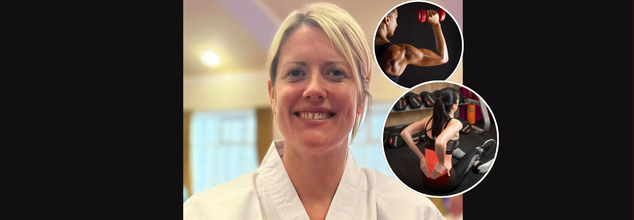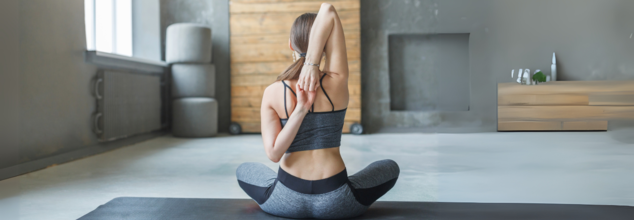
Fitness Freak Nearly Dies After Common Exercise Mistake; Here's What She Did Wrong
Exercise is the key to good health, but as with anything—even water or vitamins—too much of a good thing can be dangerous. For 41-year-old Gemma Underwood, a Scottish fitness enthusiast and orange belt in karate, her passion for training nearly cost her life. What started as an “intense” martial arts session led her down a frightening path to the emergency room, where she was diagnosed with a rare and potentially deadly condition called rhabdomyolysis. Her story is a sobering reminder for gym-goers and athletes everywhere: fitness without balance can be fatal.
It was just another training day in March for Underwood in South Ayrshire, Scotland. Her karate session had been grueling, pushing her physical boundaries, but she felt satisfied—until the next morning. Unable to get out of bed due to severe muscle pain and swelling, she noticed her arms had ballooned, and her muscles were extremely tight. But the most alarming sign was what she saw in the bathroom mirror: her urine had turned a disturbing dark brown, which she described as resembling “Coca-Cola.”
Panicked and confused, Underwood rushed to the emergency room. Medical professionals quickly diagnosed her with rhabdomyolysis, often referred to as “rhabdo,” a serious condition involving the breakdown of muscle tissue that releases toxic proteins—specifically myoglobin—into the bloodstream. If untreated, these proteins can clog the kidneys, leading to kidney failure or even death.
What is Rhabdomyolysis?
Rhabdomyolysis is not commonly discussed in mainstream fitness conversations, but it’s a well-known risk among medical professionals and elite trainers. According to the Cleveland Clinic, rhabdo occurs when skeletal muscle breaks down rapidly due to extreme physical exertion, trauma, or dehydration. As muscle fibers die, they release their contents into the bloodstream, overwhelming the kidneys and potentially causing multi-organ failure.
Symptoms vary and can be deceptively mild in early stages. They typically include:
- Muscle pain, swelling, or tenderness
- Weakness or difficulty moving limbs
- Fatigue or malaise
- Nausea or vomiting
- Significantly reduced urination or dark-colored urine (a major red flag)
In Underwood’s case, the condition escalated quickly—an all-too-common reality when the signs are misunderstood or ignored. Doctors told her the cause was likely inadequate hydration during her intense workout. “I wasn’t hydrated enough,” she admitted. “I should have been drinking more water before.”
Water plays a vital role in preventing rhabdomyolysis. Without enough fluids, the kidneys struggle to flush out myoglobin and other harmful muscle breakdown products. During strenuous exercise, particularly in high-heat environments or lengthy sessions, fluid loss through sweat increases dramatically. If not replenished, the body enters a state of dehydration, magnifying the impact of muscle strain.
Despite being fit and experienced, Underwood made the critical mistake of underestimating her hydration needs—a mistake that nearly proved fatal.
Underwood spent five days in the hospital receiving intravenous fluids and was fitted with a catheter to monitor kidney function. She’s now on a mandatory exercise hiatus for at least three weeks and has made hydration a top priority.
“I’m currently resting, no exercise at all, and drinking plenty of fluids,” she shared. “It was terrifying knowing I could’ve died from something that seemed so routine. Make sure you're hydrated before any workout, no matter how intense it is.”
Her message is clear: no one is immune to the dangers of overtraining. Her story is a cautionary tale not just for elite athletes but for anyone who steps into a gym or takes on a new fitness challenge without adequate preparation.
How to Exercise Smart and Stay Safe?
While rhabdomyolysis is rare, it’s becoming increasingly common among high-intensity workout communities, especially in CrossFit, spin classes, and boot camps where participants are encouraged to push limits. The good news? It’s entirely preventable.
Here’s what every exerciser should remember:
Hydration is non-negotiable: Drink water before, during, and after workouts. Electrolytes help too.
Ease into new routines. Whether you’re new to fitness or returning after a break, increase intensity gradually.
Listen to your body. Pain and fatigue are signals, not challenges to override.
Know the symptoms. Dark urine, severe swelling, and unexplained weakness are not to be ignored.
Rest and recovery matter. Muscles grow and repair when you rest—not when you overtrain.

Credits: Canva
What Is Fartlek? The Simple Running Trick Backed By Science To Supercharge Your Stamina
Whether you’re training for your first 5K or looking to smash a marathon PR, fartlek could be the game-changing workout your running routine is missing. Fartlek is Swedish for “speed play,” this unique running method blends freedom with structure, play with performance, and science with simplicity and it might just be your secret weapon for endurance, speed, and improved cardiovascular health.
Fartlek training was invented during the 1930s by Swedish Olympic trainer Gösta Holmér, who was looking for a method to make his athletes faster and more resilient without the tedium of repetitive exercise. In contrast to regular interval training, in which recovery periods are specifically set, fartlek promotes ongoing movement with changing intensity alternating sprints of speed with slow recovery runs, all without stopping.
This "playful" approach not only wards off boredom but also provides a smooth transition between base running and more formal speed work. It's a method that encourages spontaneity while enjoying serious physiological rewards.
What Exactly Is a Fartlek Run?
Fundamentally, fartlek is a type of unstructured speedwork. In a fartlek session, you vary between harder and easier running, but in contrast to intervals, there are no full rest pauses. You may sprint for one minute, jog for three, run hard to the next tree, then recover until the next lamppost.
You can create your own rules based on either time or distance. For instance:
- 1 minute fast, 3 minutes easy
- Half a mile fast, half a mile recovery jog
Why Fartlek Training Works?
Fartlek is not merely a curiosity of bygone days. It's grounded in exercise physiology that makes sense of its utility for building cardiovascular endurance, lactate threshold, and muscular economy. Since the "recovery" periods are still working hard, your heart rate stays high, putting extra stress on your aerobic system — which is a potent tool in the hands of long-distance runners and recreational joggers alike.
Further, pace variation also enhances the ability of your body to recycle lactate, with an overall energy expenditure. Fartlek training serves to condition your body to excel in conditions experienced in real races, where the pace can constantly change with the terrain, competitors, or wear and tear.
For novices or runners coming back from a break, fartlek provides an easy point of entry to increased-intensity work. With no stopwatch or track required, it eliminates intimidation and lets you tap into your perceived effort. You're not tied to strict measures — you just run by sense.
That flexibility is also what makes fartlek perfect for use in initial stages of a training cycle. It gets the mind and body ready for more organized sessions in advance, without burning them out.
Fartlek vs. Other Speed Workouts
Let's discuss how fartlek is different from tempo runs and interval training:
Tempo runs: Consistent runs at a "comfortably hard" rate — usually around 20–45 seconds slower per mile than your 5K pace. They develop lactate threshold but lack the same variability as fartlek.
Intervals: High-intensity efforts with full recovery or slow recovery (e.g., 8 x 400m with full recovery). They're more structured and performance-oriented than fartlek.
Fartlek: Balances speed and endurance without full rest. Less predictable, more flexible — and sometimes more fun.
Why You Need to Add Fartlek into Your Training?
1. It Mirrors Race-Day Reality
Races are not run at a set pace with prearranged recovery periods as with intervals. Fartlek simulates the unpredictable nature of racing — surges, hills, and tactical fluctuations — making you more resilient.
2. It Educates Self-Regulation
By allowing you to control when to accelerate and decelerate, fartlek training develops body awareness. You'll discover how to monitor effort, deal with fatigue, and adjust pace — essential skills for any distance runner.
3. It's Efficient and Convenient
With hectic lifestyles, sometimes all you can manage is 20–30 minutes. A short fartlek session over lunch or on a nearby trail can bring significant payback in a concise manner.
4. It Keeps Things Fun
Running doesn't have to be all about numbers. Fartlek brings some spontaneity into your routine. Skip the GPS watch, select a scenic route, and let your instincts dictate your pace.
Key Fartlek Workouts to Try
1. Free-Form Fartlek
Select a natural route and perform 10–25 short bursts (15 seconds to 4 minutes) with steady running in between. Use landmarks as your navigation.
2. Bridging Fartlek
Perfect early in a training plan: attempt 10 reps of 30 seconds hard, 90 seconds steady — building over time to 1-minute hard, 1-minute steady.
3. Mixed Paces
Develop endurance with decreasing intervals: 6, 5, 4, 3, 2, 1 minutes — increasing the pace as you go, with 90 seconds of slow running in between attempts.
5. Marathon Prep Fartlek
Alternate 3 minutes slower than marathon pace with 3 minutes faster for 60 minutes of a longer 75–90-minute run.
Fartlek training may not receive the same banner headlines as high-tech interval training or boutique studio classes, but its very simplicity is its genius. Supported by decades of practice and current science, this vintage approach continues to pay dividends in stamina, speed, and aerobic fitness while keeping running interesting and enjoyable.

(Credit-Canva)
Build Better Balance With These Yoga Poses Tips
Yoga poses may seem easy to do, or something that should not require a lot of strength and endurance. However, the people who do practice yoga know that not only do you need good strength, endurance, but also focus and balance. Even for basic poses, one needs a semblance of control over their movements and enough balance to hold the poses for a period.
Here Are Ways To Enhance Your Stability In Yoga Poses
You can improve your balance in yoga while you're still working on it. You just need to give yourself some time to learn. These tips can help you feel steadier in your yoga practice, whether you feel shaky just standing or you're aiming for more advanced one-legged poses.
Feel the Floor
Yoga teachers say "ground into the mat." For beginners, feel a strong link between your body and the floor. Like a building needs a good base, pay attention to your toes, the balls of your feet, and heels pressing down. Gently lift the middle of your feet to feel steady.
No Socks, No Shoes
Your balance uses your eyes, ears, and how your feet feel the ground. Taking off socks and shoes lets the bottom of your feet directly touch the mat. This feeling helps your body know how to stay balanced.
Body Like Building Blocks
After feeling the floor, focus upwards. Think of your body as blocks stacked on each other. Start with your feet and line up your ankles, knees, and hips. Keep your spine straight and your shoulders over your hips, reaching the top of your head up.
Wake Up Your Muscles
Standing in yoga needs your muscles to be active, not floppy. Use the small muscles in your feet, legs, and your core (belly, back, and glutes) to help you stay steady. Pushing down through your heel can help turn these muscles on.
Look at One Spot (Drishti)
To balance better, look at one still thing straight ahead. This is called drishti. If you're wobbly, pick a spot on the wall and keep looking at it. This helps your eyes and inner ears keep you steady.
Use Your Middle
Remember to use your whole middle part, your back and butt muscles too, not just your belly, to help you balance. Keeping these muscles firm helps your spine and hips stay still, making your whole body more stable.
Keep Breathing Slowly
When you're balancing, pay attention to your breath. Breathe in and out slowly and focus on it. This helps you stay in the moment and keeps your mind from wandering, which helps you stay balanced.
Use a Little Help
It's okay to use support, like training wheels on a bike. If you're learning or having a bad day, practice near a wall or chair so you can hold on if you start to wobble.
Widen Your Feet
If you feel shaky when standing with both feet down, try putting them a little wider apart, like hip-width. This makes your base bigger and more stable. Imagine standing on train tracks, not a tightrope.
Start Easy
You don't have to do hard one-legged poses right away. Practice feeling steady in simple standing poses first. Maybe try just lifting one knee up for a bit. Be patient with yourself; balance takes time and practice.

(Credit-Canva)
Woke Up On The Wrong Side Of Bed? Shoulder And Neck Yoga Stretches For Relief
Sometimes sleeping in the wrong position can turn out to be detrimental to your body. Waking up on the wrong side of the bed could result in stiff muscles, which cause immense pain. So, how does one fix this issue?
Yoga is a great way to solve muscle or body pain. With the help of asanas and stretches, you can relax your body and be relieved of the pain. Not only will they help you start your day, devoid of pain, but you will also get a burst of energy to get you through the day.
You don't have to be a yoga expert or incredibly flexible to do many of these poses. There are many online tutorials, videos and guides that can help you build and practice the routine. These poses are especially helpful for those mornings when you wake up with tightness and stiffness in your neck and shoulders, offering a way to find some relief before the day's tension builds up even more.
Mountain Pose with Eagle Arms
Stand tall with feet hip-width apart. Roll shoulders down. Bring arms forward, bend elbows. Cross your right arm under your left, and try to touch your palms. Pull shoulders down, lift elbows, move hands away from face. Breathe deeply into your upper back.
Chin Tuck and Backbend
For a deeper stretch, gently tuck your chin to your chest. Feel it between your shoulders and back of your neck. Breathe slowly. Lift head and elbows, gently lean back a little. Stay and breathe. Then, release arms. Swing them out or bend like cactus arms to stretch your chest. Relax shoulders. Repeat other side.
Standing Forward Bend
Stand with feet a bit wider than hips. Clasp hands behind your lower back. Roll shoulders back, open chest. Bend knees a little, fold forward. Reach knuckles up and over your head. If hands clasped hurts, just let them hang. Let your head be heavy, relax your face. Try to lift knuckles higher and breathe.
Rag Doll Pose
Release your hands. Grab opposite elbows. Gently sway side to side. Slowly turn your head from side to side. This helps release any tightness in your neck and upper back. Just let your body move gently and feel the stretch.
Low Lunge with Neck Stretch
From forward bend, put your hands on the floor. Step left foot way back, left knee down. Keep your left hand on floor. Reach your right hand to your lower back, roll your right shoulder back a little. Let your left ear move towards your left shoulder. Stay or gently move your head. Breathe smoothly and relax your hips.
Thunderbolt with a Backbend
Slowly come up. Put hands on floor by front foot. Step right foot back to meet left. Kneel, sit on heels. Put fingertips on your lower back, and bend your elbows. Squeeze your shoulders and elbows together. Lift your chest and open your collarbones. Breathe. Repeat the other side for Low Lunge. Repeat Thunderbolt.
Child’s Pose
Bring big toes together, widen knees gently. Lean forward, stretch arms out. Rest forehead on floor. For a deeper upper body stretch, put palms together, bend elbows, thumbs towards back of neck. Breathe slowly. If hands are in prayer, straighten arms slowly and walk hands back as you sit up.
© 2024 Bennett, Coleman & Company Limited

